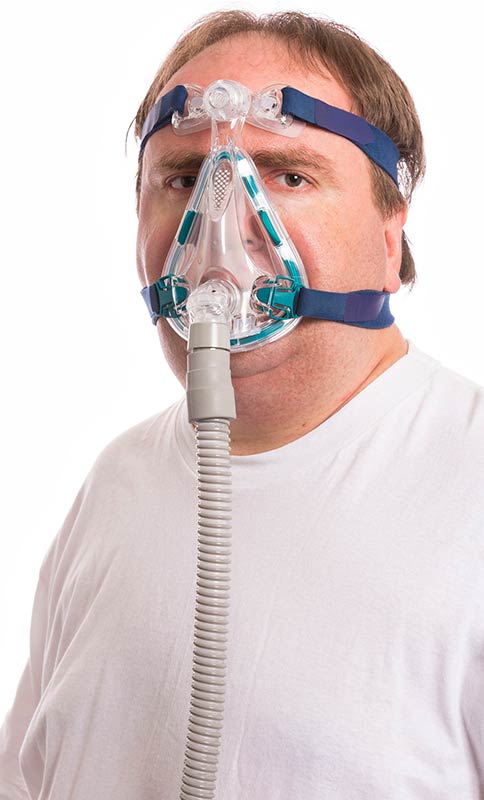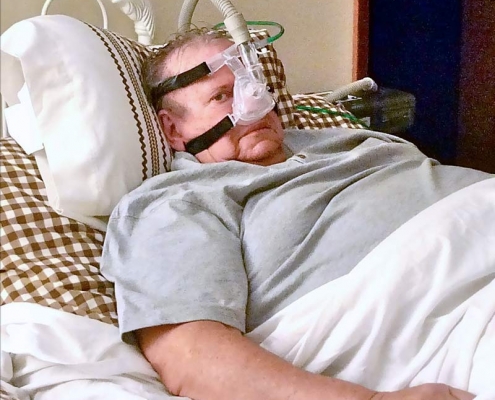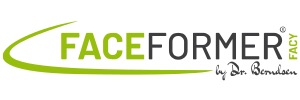Sleep apnea
Treating causes instead of just symptoms
Treating causes instead of just symptoms
The process of inhalation is assisted by permanently applied air pressure and exhalation is directed with increased effort against the artificially generated airflow. These altered, unnatural pressure conditions can damage the delicate, sensitive tissue of the lungs. The patient’s own active breathing becomes accustomed to the easier breathing and reduces its activity. The technical breathing pressure must be increased accordingly. The risk of lung damage increases again.
Inhalation and exhalation are exactly the opposite of physiological breathing. During inhalation, the air is pushed into the airways instead of being sucked in and exhalation takes place against incoming air instead of flowing out without resistance.
The change in the physiological breathing process creates a new stimulus/response pattern and irritates the polysynaptic reflex action of the complex breathing mechanism – including remote effects via receptors in the nose and the olfactory function.
Altered information stimuli to the respiratory system cause functional processes in the brain to change. The production and interaction of neuromodulators and the associated receptors change. It is unclear what effect this has. What is certain, however, is that breathing is an essential prerequisite for brain metabolism and supports the production of neurotransmitters. Stimulus changes depend on the degree of intensity and the associated reactive consequences. If they are too great, they can support the development of neurodegenerative diseases such as dementia, Alzheimer’s, Parkinson’s disease, etc.
Positive airway pressure devices with various technical principles, such as CPAP, also commonly referred to as PAP devices, are considered the gold standard in the treatment of obstructive sleep apnoea syndrome. The abbreviation CPAP stands for “Continuous Positive Airway Pressure”. In this technique, a compressor generates compressed air. This is fed continuously into the upper airways at the same intensity via a tube and a face mask connected to it. A positive air pressure (PEEP) is created there, which is permanently directed against slack tissue like a support (air splinting). This is intended to widen the airways and support the patient’s own breathing.
Is “gold standard” the right term for a method that merely suppresses symptoms and cannot correct the underlying problem of the disorder? If one considers the benefits of the method solely on the side of industry and practitioners, the term is certainly correctly applied. For patients, however, causal treatments are generally considered the first choice and therefore the “gold standard”. Nevertheless, symptomatic therapies dominate the field and usually create lifelong dependencies on medication or aids. Taking into account the semantics of the word, such therapies are far removed from “gold” (noble) and belong to the category of “alternative treatments”.
All hyperbaric treatments have a “crutch function”, their effect is solely focused on the symptom and can only occur in moments of immediate application. If the patient does not find new ways, he or she will be dependent on the use of a costly “crutch” for the rest of his or her life once the device therapy begins. There is no chance that positive pressure treatment will ever result in natural breathing behavior independent of the device.

Many patients do not accept CPAP treatment in the long term.
The first CPAP supplies began in 1983 and since then a large number of sleep laboratories have been established and with them the use of positive pressure breathing with technical equipment has spread rapidly. Every year, about 45 000 people join the lifelong community of users. The costs for a device range from 1.500,00 € to more than 5000,00 €. Added to this are expenses for masks, regular examinations, stays in sleep laboratories, maintenance and replacement of equipment and masks, etc. It is therefore not surprising that the method has long since reached the 1st place on the cost hit list of all medical-technical supplies.
The willingness of patients to use CPAP therapy (compliance) varies greatly. Many have the respiratory aid, but do not use it because they find the application unbearable or annoying. Allegedly, a maximum of 50% of the prescribed devices are used regularly.
The chances of success of CPAP therapy are often given as 97 %. Obviously, patients who own a device and do not use it are not considered. In addition, only parameters that are directly related to respiratory effects are considered. For example, fewer breathing stops, better oxygen supply, change in sleep architecture, reduced daytime tiredness.
Other associated promises such as preventive effects against cardiovascular diseases, strokes and heart attacks cannot be proven to date. On the contrary, international studies from the year 2017 even show an increase in the mortality rate of patients who use positive pressure breathing for such pre-existing conditions. Side effects have also hardly been mentioned or investigated so far. This is due on the one hand to the large number of possible initial and boundary conditions, interactions, influences and comparisons. On the other hand, the method objective alone distorts such efforts. After all, it is aimed at reducing breathing stops and if this is successful, it must be beneficial to health even if this is achieved by positive pressure breathing. The fact that positive pressure breathing cannot exist without side effects is discussed in the following sections.
However, application disorders are described under the exclusion of health side effects:
Statements that early PAP therapies protect against life-threatening diseases of the heart, circulation and brain are derived from less potent studies, seemingly plausible explanations, publications financed by manufacturers and acclamations by uncritical experts and users. These statements lack relevant scientific evidence. They are based solely on an apparent logic: anyone who breathes too little at night unobserved and does not supply their organs with sufficient oxygen must be close to the end! Woe betide anyone who does not believe this or contradicts it!
Summarized evaluations of recent scientific studies, in which several thousand patients (approx. 10,000 in total) took part for the first time and which were conducted under the direction of renowned scientists in various countries, cannot confirm the seemingly plausible, beneficial effects of positive pressure breathing.

The study examined 2717 patients from 89 research centers in seven countries. All of them had sleep apnea syndrome and pre-existing conditions such as coronary heart disease, strokes or other cerebrovascular pathologies. It was found that the incidence of heart attacks, cerebral infarctions, heart failure and deaths did not decrease in the groups using positive pressure breathing devices, but actually increased.
The use of an adaptive servoventilation device, which is mainly used in patients with Cheyne-Stokes respiration and is considered a technical optimization of PAP devices, significantly increased the death rate, although the device drastically reduced the number of respiratory failures. The researchers (Ulysses Magalang from the Wexner Medical Center, Columbus and Allan Pack from the Perelman Scool of Medicine in Philadelphia, among others) consider ventilation components, such as the constant positive airway pressure generated by the device, to be a possible cause. The authors of the Jama study (2017), which was based on 7266 patients, also found no reduction in the risks and occurrence of death from cardiovascular disease, regardless of whether the patients were fitted with PAP devices or not (study – JAMA July 11, 2017 Volume 318, Number 2).
Association of Positive Airway Pressure With Cardiovascular Events and Death in Adults With Sleep Apnea – A Systematic Review and Meta-analysis
Jie Yu, MD1,2; Zien Zhou, MD2,3; R. Doug McEvoy, MD4; et alCraig S. Anderson, PhD2,5,6; Anthony Rodgers, PhD2; Vlado Perkovic, PhD2; Bruce Neal, PhD2,7,8
JAMA. 2017;318(2):156-166. doi:10.1001/jama.2017.7967
Patients with acute respiratory distress syndrome (ARDS) are given artificial respiration because they are no longer able to breathe adequately and would therefore die. The decision in favor of this measure is always associated with a conflict: on the one hand, there is a positive effect because the airways and lungs expand due to increased breathing pressure. This creates the conditions for the vital exchange of oxygen and carbon dioxide. On the other hand, however, the ventilation pressure damages the lungs and the lung tissue reacts with inflammation as a defense reaction. The application therefore often ends fatally and even survivors do not remain without serious consequential damage.
The same does not apply to positive pressure breathing. With artificial respiration, the machine takes over the breathing activity. A tube is inserted directly into the trachea. With positive pressure breathing, on the other hand, the patient can breathe on their own. During sleep, however, the airway passages are repeatedly constricted by sagging tissue in the throat. The permanently applied air pressure is intended to push the tissue out of the airways (air splinting), thus preventing obstructions and allowing the user to breathe unhindered.
Human respiration regulates gas exchange in the lungs. From there, oxygen is transferred to the blood and transported to the body cells. There is two-way communication between the brain and the respiratory organs via neuronal and endocrine mechanisms.
Breathing is generated by a self-regulating “pulse generator” in the brain stem and other interacting brain regions, which check the mixing ratios of the air we breathe and coordinate and adjust rhythms. These mechanisms react to both physical and mental stress changes and regulate the tension activity of the impulse-controlled respiratory muscles, such as the scalenus muscles (large auxiliary respiratory muscles), intercostal muscles (intercostal muscles) and diaphragm. During inhalation, the respiratory muscles coordinate and tense, expanding a vacuum space that surrounds the lungs inside the body. This creates suction on the lung tissue and the lungs expand. A vacuum is created inside the lungs, which extends to the upper airways and draws the air into the lungs (inspiration).
During exhalation (expiration), elastic fibers of the lung parenchyma (breathing space of the lungs) contract the lungs – again passively – as soon as the respiratory muscles relax. The used air is thus expelled from the lungs and exhaled (expiration).
In the previously described global study on the effect of PAP therapies, the researchers found that the mortality rate increased in the group of patients who were treated with PAP devices, even though the number of respiratory failures had decreased. The scientists suspect that this is due to the influence of device ventilation, for example the constant positive airway pressure.
We take up such assumptions and try to scientifically examine facts and correlations that have rarely been discussed so far with reason and logic.
The lungs consist of soft, spongy tissue. The reactions between its tissue, the air currents and its fluid are realized in a sensitive and complicated way. To date, there is no measurement method to understand processes that occur at the lung micro level.
It must be assumed that even minor deviations affect the lungs and the entire respiratory system. The anatomist and developmental biologist Wilhelm Roux (1895) explained such correlations for all human systems: According to this, any functional influences, and indeed regardless of intensity and organ, always have qualitative and quantitative consequences.
Positive pressure breathing meets the innate, vital basic pattern of breathing, which is maintained from the first to the last breath. When positive pressure breathing is used, the usual breathing pattern is subordinated to the technique. This requires the following serious changes.
The process of inhalation is assisted by permanently applied air pressure and exhalation is directed with increased effort against the artificially generated airflow. These altered, unnatural pressure conditions can damage the delicate, sensitive tissue of the lungs. The patient’s own active breathing becomes accustomed to the easier breathing and reduces its activity. The technical breathing pressure must be increased accordingly. The risk of lung damage increases again.
Inhalation and exhalation are exactly the opposite of physiological breathing. During inhalation, the air is pushed into the airways instead of being sucked in and exhalation takes place against incoming air instead of flowing out without resistance.
The change in the physiological breathing process creates a new stimulus/response pattern and irritates the polysynaptic reflex action of the complex breathing mechanism – including remote effects via receptors in the nose and the olfactory function.
Altered information stimuli to the respiratory system cause functional processes in the brain to change. The production and interaction of neuromodulators and the associated receptors change. It is unclear what effect this has. What is certain, however, is that breathing is an essential prerequisite for brain metabolism and supports the production of neurotransmitters. Stimulus changes depend on the degree of intensity and the associated reactive consequences. If they are too great, they can support the development of neurodegenerative diseases such as dementia, Alzheimer’s, Parkinson’s disease, etc.
The results of the largest studies to date (approx. 10,000 patients) show that although the use of PAP devices can reduce respiratory failures, more patients treated with PAP died than in the untreated comparison groups. In this respect, the therapy can be assumed to have more harmful than positive effects. The assumption that people with respiratory failure improve their health through positive pressure breathing is in fact the opposite. Considering the objective effects we have described and the known fatal reactions to artificial ventilation, this is a logical consequence. The enormous number of device prescriptions is therefore not only unjustified, but even dangerous. However, it is to be expected that the bloated lobby system of industry, sleep laboratories and epigones of therapy will prove resistant to such effects.
Biologically functioning breathing behavior (habitual nasal breathing instead of mouth breathing), mouth closure, tongue tension, coordinated muscle tension and muscle chain functions in the nose, mouth and throat are prerequisites for unhindered healthy breathing day and night. Incorrect behavior in one or more segments cannot be positively changed by insight or good intentions. Even nasal sprays cannot change the incorrect breathing behavior, but they destroy the delicate defense system of the nasal mucosa in the long term. Finally, there is also a choice of surgical interventions and aids. However, surgical interventions always involve additional risks, cannot change habitual incorrect behavior and have no guarantee of success. Devices only have supportive properties. They therefore impair the body’s own abilities and create a permanent dependency.
Disturbed respiratory functions, such as nocturnal breathing interruptions, can only be corrected and stabilized in the long term through neurophysiological exercise treatment. Complex coordination mechanisms are trained with elements such as posture, tension and movement patterns in the mouth/pharynx and respiratory tract, balanced head posture and habitually correct breathing behavior. The FaceFormer training therapy was developed based on the findings of modern neuroscience.

FaceFormer therapy is used successfully all over the world.
With the FaceFormer, identical exercises are practiced regularly over a limited period of time. As soon as resistance-free breathing through the nose has become automatic, the program can be completed. The newly learned skills are retained for a long time: Natural breathing through the nose succeeds day and night. A successful recipe for preventing and shielding against pathogens, allergies, snoring, nocturnal breathing interruptions and much more.
You can purchase your FaceFormer online in the Dr. Berndsen Shop, from our sales partners or from numerous doctors and therapists or locally in your pharmacy.
Ask for the central pharmaceutical number PZN 18092273 (FaceFormer ONE blue).
Further product variants and useful accessories are available.
Saving tip especially for doctors and therapists: 20%++ discount on orders of 5 FaceFormers or more!
The effective solution for snoring, sleep apnea, CMD, jaw problems and many other indications. Simple, causal, effective.
Der FaceFormer ONE Der FaceFormer, ein Medizinprodukt der Klasse 1, ist aus medizinischem Elastosil gefertigt und garantiert schadstofffrei. Die Therapie zielt darauf ab, fehlerhafte Funktionsabläufe zu korrigieren, die verschiedene Symptome beeinflussen können. Seit zwei Jahrzehnten stellt die FaceFormer-Therapie eine…
Die FaceFormer® Therapie: Der FaceFormer, ein Medizinprodukt der Klasse 1, ist aus medizinischem Elastosil gefertigt und garantiert schadstofffrei. Die Therapie zielt darauf ab, fehlerhafte Funktionsabläufe zu korrigieren, die verschiedene Symptome beeinflussen können. Seit zwei Jahrzehnten stellt die FaceFormer-Therap…
Der neue FaceFormer® ZERO Auf vielfachen Anwenderwunsch hat die FaceFormer Familie Zuwachs bekommen. Zusätzlich zum bekannten FaceFormer ONE in blau oder kristallklar ist ab sofort der FaceFormer ZERO erhältlich. Was ist anders? Der FaceFormer ZERO weist eine geringere Materialhärte auf, als die bisherigen Modelle. Grö…
FaceFormer® ZERO & ONE Therapie-Set für Erwachsene Überblick: Dieses Therapie-Set umfasst die Modelle FaceFormer ZERO und FaceFormer ONE. Beide sind als medizinische Geräte der Klasse 1 aus medizinischem Elastosil® hergestellt und sind BPA-frei sowie frei von flüchtigen Stoffen. Sie sind speziell darauf ausgelegt, die …
Wasserstr.25
59423 Unna
Germany
+49 (0) 23 03-89 99 1
+49 (0) 23 03 – 89 88 6
Mo. to Fr. from 8:00 to 16:00

 Mouth breathing is harmful to health
Mouth breathing is harmful to healthThis site uses cookies. By continuing to browse the site, you are agreeing to our use of cookies.
OK, agree with allAgree to essentialsShow settingsThe satisfaction of visitors to our website is important to us. In order to better address you, we use cookies. Thereby we achieve that the website works technically reliable and secure.
You can change or revoke your consent at any time.
In the privacy policy you can learn more about cookies and privacy setting.
View privacy policy
Essential cookies enable basic functionality and are necessary for the proper functioning of the website.
This data may be linked to user information of users logged in on youtube.com and google.com.
YouTube video embedding
Used to unlock YouTube content.
Google Analytics
Cookie from Google for website analytics.
Generates statistical data about how the visitor uses the website
